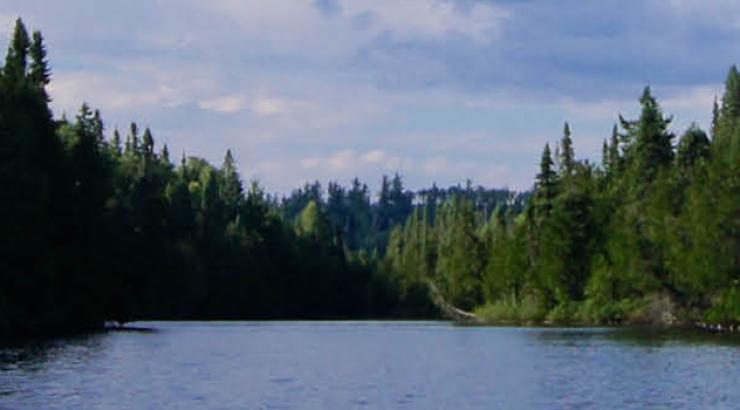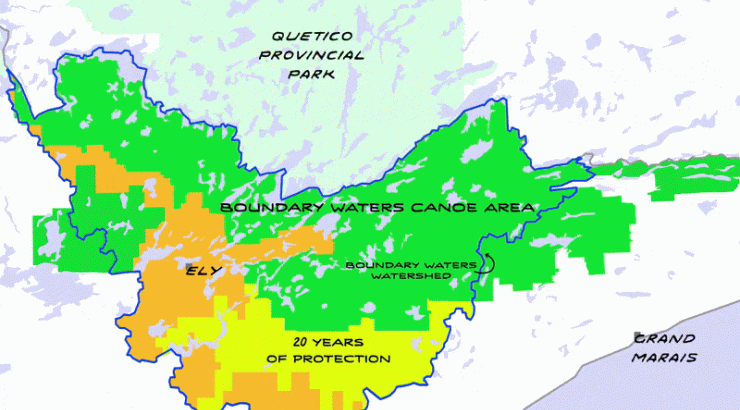Have you wanted to understand more about the mineral lease renewal process for the mining proposals we've discussed? Or wanted to understand the environmental review possibilities, such as an in-depth Environmental Impact Statement (EIS)? Read this article for a deeper understanding.
Lease renewal latest flashpoint in mine debate: Opponents of copper-nickel mining call for environmental impact statement
This ![]() piece, written by Marshall Helmsberger, originally ran in the May 15, 2015, issue of the Ely Timberjay and is reprinted here with permission.
piece, written by Marshall Helmsberger, originally ran in the May 15, 2015, issue of the Ely Timberjay and is reprinted here with permission.
An ongoing effort by Twin Metals to renew two federal mineral leases has become the latest pint of conflict over the prospect of copper-nickel and precious metals mining within the Superior National Forest.
The company is also seeking to convert three existing prospecting permits into what are known as preference rights permits, which could eventually give the company the right to mine.
In all, the permits cover several thousand acres running roughly parallel to the South Kawishiwi River, southeast of Ely.
Opponents of the proposed mine, who are fearful of the water pollution within a major Boundary Waters watershed, have asked the Bureau of Land Management, which overseas the mineral rights on federal lands, to conduct a full Environmental Impact Statement, or EIS, before renewing the permits. Jason Zabokrtsky, of Ely, an organizer with the Campaign to Save the Boundary Waters, said the EIS is an opportunity to take a “big picture” look at whether a mine is compatible with the vast water-based wilderness located downstream.
Any decision to complete an EIS could add two years or more to the renewal process and create uncertainty as Twin Metals seeks to advance its mining proposal. Company spokesman Bob McFarlin called a full EIS “unwarranted,” and said it’s never been done on a mineral lease renewal request before.
Lease History
The federal Bureau of Land Management first issued the two existing federal mineral leases, known as MNES 1352 and MNES 1353, to the International Nickel Company, or INCO, back in 1966. The preference rights leases, which are the only two such leases ever issued on the Superior National Forest, have changed hands over the years, and today are controlled by Twin Metals and its parent Antofagasta.
The original lease remained in effect for 20 years, and has twice been renewed for ten years each time. The two leases most recently expired Dec. 31, 2013, and in anticipation of the fact, Bever Bay Inc., a company headed by longtime prospector Ernie Lehman, began the reapplication process back in Ocotber 2012. That entity has since been acquired by Antofagasta.
While the BLM approved previous renewal requests through a limited review process, know as a categorical exclusion, the agency has decided to conduct a broader environmental assessment, or EA, this time around. BLM officials originally told Twin Metals that they expected to release a draft of the EA by the end of 2013. Now, nearly a year and a half later, there’s now sign of the EA and federal officials say there still not sure how to proceed with the renewal application process. “It’s not a straight-forward process,” said Kris Reichenbach, spokesperson for the Superior National Forest. While the BLM manages federal minerals, the affected surface lands are governed by the Forest Service and both agencies are coordinating in the ongoing review and must have concurrence on the application before it can proceed. “My understanding is that there are ongoing discussions between BLM and at higher levels within the department,” she said.
Reichenbach said part of the delay stems from the fact that the original lease was issued prior to the passage of the National Environmental Policy Act, or NEPA, when requirements were much different from today. “Now the question is what is the appropriate way to issue a renewal based on current guidelines,” said Reichenbach. “We’re doing some trailblazing here.”
Groups see need for broader discussion
Opponents of copper-nickel mining on the edge of the Boundary Waters say the lease renewal may be the only opportunity for a public debate on whether a mine is an appropriate development for the area. They say once Twin Metals proposes a mine plan, any subsequent environmental review will be focused more narrowly on the environmental effects of the proposal, and it won’t provide the opportunity to highlight alternative native futures for the area. “Now is the time for the BLM to step back and asses whether this location is an appropriate place to do this,” said Zabokrtsky. “It’s the one time they can look at this in a broader context, considering the values of multiple uses of this land versus the single use of a mine. This project really fits the standards for requiring a thorough EIS review.
Zabokrtsky said as more information has come out in recent years, the risks of a mine are clearer than they were when the leases were originally issued. “There’s so much new science on the issue as far as the risks to human health and this very unique and fragile ecosystem,” he said. “Our campaign has worked really hard to pull the science together and to make people aware of it.”
The campaign is hoping that the BLM will ultimately decline to renew the leases, but even if they lose that fight they see benefits from highlighting the science they say supports extreme caution towards any mining proposals near the BWCAW. “Given the value of the wilderness and [the mine’s location] in the heart of a very important economic area for St. Louis and Lake counties, there’s a big cost in dislocating all of that investment and economic activity,” said Becky Rom, who heads up the campaign. “This is the opportunity to really look at that and make an informed decision, based on the science.”
By contrast, Twin Metals officials say there really isn’t much to talk about when it comes to the lease renewals. Twin Metals’ McFarlin said that the company has no objections to the completion of an EA, which as already been decided in either case. “The bigger issue is the request to do a full-blown EIS. That certainly would be unwarranted and unprecedented,” he said.
McFarlin said if mine opponents want to have a broader discussion about the prospect of mining in the area, an EA would provide that opportunity. “That opportunity will come when the EA is released.” That’s when a public comment period gets underway.
As for assessing environmental effects, McFarlin said the lease, by itself, has no effects. “These are contractual documents. They give the right to propose activities in relation to the leases, but it’s not until you proposed physical activities that you have something to study.”
McFarlin said the BLM granted previous renewals without any significant environmental review and without any changes to the stipulations included in the original agreement. “We wouldn’t be surprised to see some updated stipulations,” said McFarlin. But, he added, company officials don’t believe the BLM can deny the renewals under the current circumstances.
In the meantime, the terms and conditions of the now-expired lease remain in effect.” Even so, said McFarlin, “we’d like to see the BLM get the process moving again.”



